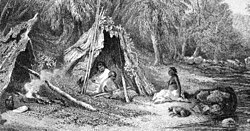Difference between revisions of "AY Honors/Aboriginal Lore/Answer Key"
From Pathfinder Wiki
< AY Honors | Aboriginal LoreAY Honors/Aboriginal Lore/Answer Key
(corrected spelling of "spelled") |
|||
| (7 intermediate revisions by the same user not shown) | |||
| Line 1: | Line 1: | ||
| − | + | [[Image:Indig1.jpg|thumb|250px|A 19th century engraving showing Aboriginal people and humpy.]] | |
| − | + | A '''humpy''' is a small temporary shelter made from bark and tree branches, traditionally used by [[Australian Aborigines]]. A standing tree is usually used as the main support. The word humpy comes from the [[Jagara]] language (a [[Murri]] people from [[Coorparoo]], [[Brisbane]]). Other [[Australian Aboriginal languages|language groups]] would have different names for the structure. | |
| − | + | The word humpy was adopted by early white settlers, and now forms part of the [[Australian English vocabulary|Australian lexicon]]. Small impermanent dwellings, including of canvas, were often referred to as humpies. | |
| − | + | It is sometimes called a [[lean-to]], since it relies on the tree for support. | |
| − | + | ||
| + | In [[South Australia]], such a shelter is known as a '''Wurley''' (also spelled wurlie), possibly from the [[Kaurna]] language.<ref>Peters, Pam, The Cambridge Australian English Style Guide, Cambridge University Press, 1996, p818</ref> | ||
| + | |||
| + | ==See also== | ||
| + | *[[Indigenous Australians]] | ||
| + | *[[List of English words of Australian Aboriginal origin]] | ||
| + | |||
| + | ==External links== | ||
| + | <references/> | ||
| + | *[http://www.slv.vic.gov.au/pictoria/a/0/9/doc/a09287.shtml State Library of Victoria photo of Aboriginal people and humpy] | ||
| + | *[http://www.abc.net.au/queensland/federation/stories/s427956.htm article on early white settlers making humpies] | ||
{{IndigenousAustralia-stub}} | {{IndigenousAustralia-stub}} | ||
| − | + | [[Category:Australian English]] | |
| + | [[Category:Australian Aboriginal bushcraft]] | ||
[[Category:Australian Aboriginal culture]] | [[Category:Australian Aboriginal culture]] | ||
[[Category:Australian Aboriginal terms]] | [[Category:Australian Aboriginal terms]] | ||
| − | [[Category: | + | [[Category:shelter]] |
| − | [[Category: | + | [[Category:Buildings and structures]] |
| − | [[Category: | + | [[Category:Human habitats]] |
Revision as of 01:00, 24 December 2006
A humpy is a small temporary shelter made from bark and tree branches, traditionally used by Australian Aborigines. A standing tree is usually used as the main support. The word humpy comes from the Jagara language (a Murri people from Coorparoo, Brisbane). Other language groups would have different names for the structure.
The word humpy was adopted by early white settlers, and now forms part of the Australian lexicon. Small impermanent dwellings, including of canvas, were often referred to as humpies.
It is sometimes called a lean-to, since it relies on the tree for support.
In South Australia, such a shelter is known as a Wurley (also spelled wurlie), possibly from the Kaurna language.&
See also
External links
- ↑ Peters, Pam, The Cambridge Australian English Style Guide, Cambridge University Press, 1996, p818

